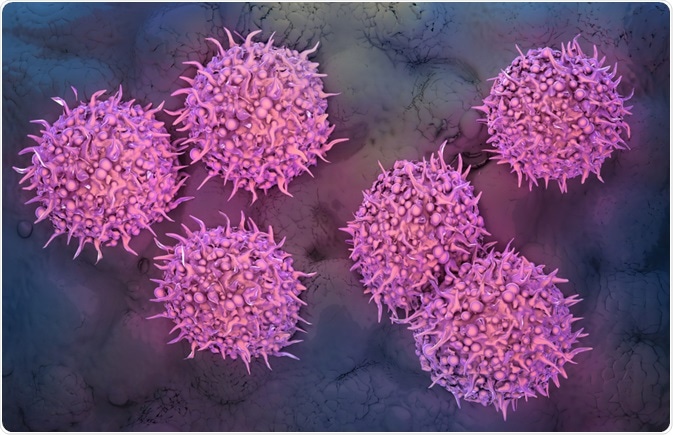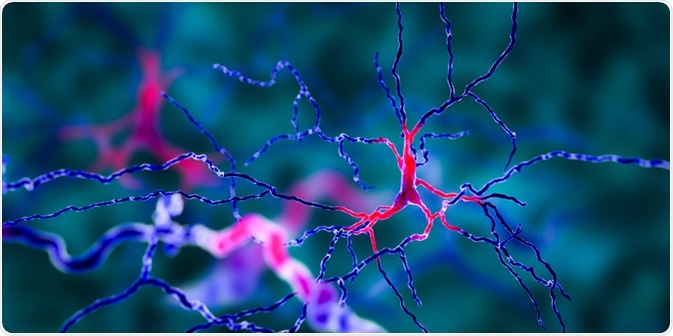Human pluripotent stem cells, including embryonic or induced pluripotent stem cells, hold great promise for disease modeling and cell therapy applications.
Human pluripotent stem cells can grow indefinitely in culture, differentiating into three primary germ cell layers, but not extra-embryonic tissues such as the placenta. This exceptional ability of human pluripotent stem cells makes them a future therapy for many health diseases.

Image Credit: Mesa Studios/Shutterstock.com
Human pluripotent stem cells in neurodegenerative diseases
Neurodegenerative diseases occur when neurons become damaged. Particular changes occur to the function of neural cells, leading eventually to cell death. The most common form of senile dementia is Alzheimer’s disease which has two types: sporadic and familial.
Generally, both types have similar clinical and pathological features, such as progressive cognitive dementia, senile plaques, and neurofibrillary tangles. Alzheimer’s disease is a chronic neurodegenerative disease, characterized by the gradual deterioration of the brain function, beginning with short-term memory loss.
With time, the disease becomes more progressive and the patient may suffer from mood swings, language problems, behavioral problems, family and society withdrawal, deterioration of body function, and eventually death.
Sporadic Alzheimer’s disease occurs randomly without a clear link to genetic causes, while familial Alzheimer’s could be mainly attributed to genetic mutations. Sporadic Alzheimer’s cases represent the major proportion, with approximately 90% of all Alzheimer’s disease cases, while familial cases are forming the rest.
Until now, there is no definitive therapy for Alzheimer’s disease. In patients with familial and sporadic Alzheimer’s disease, researchers successfully derived human pluripotent stem cells, differentiating them into neural cells. It is expected that human pluripotent stem cells could be used in the treatment of both types of Alzheimer’s diseases.
The second most common chronic progressive neurodegenerative disease is Parkinson’s disease, which is characterized by loss of the dopaminergic neurons in the brain. The extensive branching of dopaminergic neurons and the great energy amounts required to transmit nerve signals make them susceptible to degeneration. Some of the clinical features of Parkinson's disease are resting tremors, flexed posture, rigidity, bradykinesia, and loss of postural reflexes.

Image Credit: Kateryna Kon/Shutterstock.com
Mutation in PINK1, which is a gene encoding a mitochondrial protein kinase involved in the regulation of mitochondrial degradation, has been associated with genetic Parkinson’s disease.
Researchers generated induced pluripotent stem cells from skin fibroblasts which are taken from Parkinson’s disease patients. These pluripotent stem cells were then differentiated into dopaminergic neurons.
Human pluripotent stem cells in cardiac regeneration
Cellular reprogramming through induced pluripotent stem cells can be an alternative method to obtaining cardiomyocytes thanks to their ability to differentiate into cardiomyocytes.
In a study conducted on animal models, researchers found that cardiomyocytes, which are derived from pluripotent stem cells, can enhance contractile function and somewhat remuscularize infarcted areas.
Yet, there is a low ability of these cells to divide in vivo, so the effect of these cells to enhance heart function was not maintained over long follow up periods.
Low survival of the transplanted cells is one of the major drawbacks in cell therapy. Several studies found that cardiomyocytes, which are derived from human pluripotent stem cells, suffer from a low rate of survival if cells were transplanted alone.
As a way to solve this problem, the injection of cells encapsulated with biomaterials and bioengineered artificial cardiac tissue or patch has been recently developed. More studies are required to verify the therapeutic potential and side effects before this technology can be approved for clinical use.
Human pluripotent stem cells in diabetes treatment
Human pluripotent stem cells are considered to be an attractive candidate stem cell source for obtaining insulin-producing cells in a somewhat safe (without risk of rejection) and effective method (high cellular production).
However, these cells possess morphological and genetic features comparable to those of the native β cells. Both in vitro and in vivo studies revealed that induced pluripotent stem cell technology can produce fully functional β-like pancreatic cells
In 2008, Tateishi and colleagues first demonstrated that functional β cells can be generated from induced pluripotent stem cells. They found that functional (insulin-producing) islet-like clusters can be generated from human dermal fibroblast-derived induced pluripotent stem cells.
In another study, researchers can produce insulin-secreting/glucose-responsive cells from skin fibroblasts of type 1 diabetic patients through induced pluripotent stem cells. In the near future, it is expected that induced Pluripotent stem cell technology will be the hope for diabetes treatment.
Human pluripotent stem cells in cancer treatment
Induced pluripotent stem cells are considered to be new hope for cancer patients. Most cancer patients suffer from tissue damage due to radiation, chemotherapy, or the surgical treatment required to remove the tumors. Induced pluripotent stem cells can be used to replace or repair these injured or damaged tissues.
Immune therapy, based on patient-specific induced pluripotent stem cells, can be also used in cancer treatment. Human induced pluripotent stem cells derived from T lymphocytes maintain the pre-rearranged T cell receptor gene, which may provide an advantage that induced pluripotent stem cells can be differentiated into functionally active T cells that can be used against specific tumor antigens.
Sources
- Blin, G., Nury, D., Stefanovic, S., Neri, T., Guillevic, O., Brinon, B., Bellamy, V., Rücker-Martin, C., Barbry, P., Bel, A. and Bruneval, P., 2010. A purified population of multipotent cardiovascular progenitors derived from primate pluripotent stem cells engrafts in postmyocardial infarcted nonhuman primates. The Journal of clinical investigation, 120(4), pp.1125-1139.
- Hibaoui, Y. and Feki, A., 2012. Human pluripotent stem cells: applications and challenges in neurological diseases. Frontiers in physiology, 3, p.267.
- Majolo, F., Marinowic, D.R., Machado, D.C. and Da Costa, J.C., 2019. Important advances in Alzheimer’s disease from the use of induced pluripotent stem cells. Journal of biomedical science, 26(1), p.15.
- Park, M., and Yoon, Y.S., 2018. Cardiac regeneration with human pluripotent stem cell-derived cardiomyocytes. Korean circulation journal, 48(11), pp.974-988.
- Pawani, H. and Bhartiya, D., 2013. Pluripotent stem cells for cardiac regeneration: an overview of recent advances & emerging trends. The Indian journal of medical research, 137(2), p.270.
- Serra, M., Brito, C., Correia, C. and Alves, P.M., 2012. Process engineering of human pluripotent stem cells for clinical application. Trends in Biotechnology, 30(6), pp.350-359.
- Sharkis, S.J., Jones, R.J., Civin, C. and Jang, Y.Y., 2012. Pluripotent stem cell-based cancer therapy: Promise and challenges. Science translational medicine, 4(127), pp.127ps9-127ps9.
- Soejitno, A. and Prayudi, P.K.A., 2011. The prospect of induced pluripotent stem cells for diabetes mellitus treatment. Therapeutic advances in endocrinology and metabolism, 2(5), pp.197-210.
- Tateishi, K., He, J., Taranova, O., Liang, G., D'Alessio, A.C. and Zhang, Y., 2008. Generation of insulin-secreting islet-like clusters from human skin fibroblasts. Journal of Biological Chemistry, 283(46), pp.31601-31607.
- Wan, W., Cao, L., Kalionis, B., Xia, S. and Tai, X., 2015. Applications of induced pluripotent stem cells in studying neurodegenerative diseases. Stem cells international, 2015.
- Zhu, Z. and Huangfu, D., 2013. Human pluripotent stem cells: an emerging model in developmental biology. Development, 140(4), pp.705-717.
Further Reading